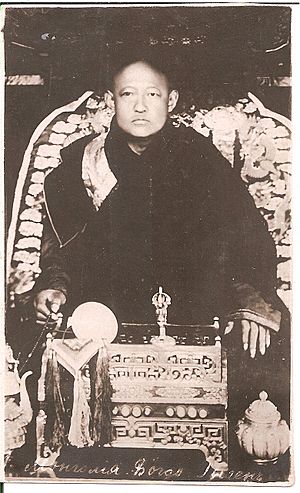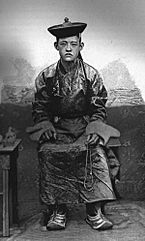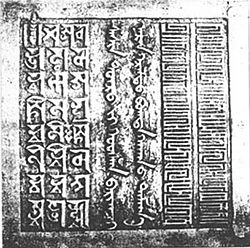Bogd Khan facts for kids
Quick facts for kids
Bogd Khan
|
|
|---|---|
 |
|
| 8th Jebtsundamba Khutughtu | |
| Preceded by | Agvaanchoyjivanchugperenlaijamts |
| Succeeded by | Jambalnamdolchoyjijantsan |
| Khagan of Mongolia | |
| In office 1911–1924 |
|
| Preceded by | Sando (as Amban of Outer Mongolia) |
| Succeeded by | Navaandorjiin Jadambaa (as head of state of the Mongolian People's Republic) |
| Personal details | |
| Born |
Agwaanl Uwsanchoizhiniam Danzan Wanchüg
c. 1869 Lhasa, Qing China |
| Died | May 20, 1924 (aged 54–55) Niyslel Khüree, Outer Mongolia |
| Spouses | Tsendiin Dondogdulam Genepil |
Bogd Khan (born around 1869, died May 20, 1924) was a very important leader in Mongolia. He was the ruler, or "khan," of the Bogd Khaganate from 1911 to 1924. This was after Mongolia became independent from China's Qing dynasty following the Xinhai Revolution.
Bogd Khan was born in Tibet. He was the 8th Jebtsundamba Khutuktu, which meant he was the third most important person in Tibetan Buddhism. Only the Dalai Lama and Panchen Lama were considered higher. People also called him the "Bogdo Lama." He was the main spiritual leader for Tibetan Buddhism in Outer Mongolia. His wife, Tsendiin Dondogdulam, was known as the Ekh Dagina. Many believed she was a special form of White Tara, a Buddhist goddess.
| Top - 0-9 A B C D E F G H I J K L M N O P Q R S T U V W X Y Z |
Early Life and Becoming a Leader
Bogd Khan was born in 1869 near Lhasa, Tibet. His birth name was Agvaan Luvsan Choijinnyam Danzan Vanchüg. His father, Gonchigtseren, worked for the 12th Dalai Lama.
When he was a young boy, he was officially recognized as the new incarnation of the Bogd Gegen. This happened in the Potala Palace with the 13th Dalai Lama and the Panchen Lama present. In 1874, the new Bogd Gegen arrived in Urga, which was the capital of Outer Mongolia. From that time on, he lived only in Mongolia.
Mongolia's Independence Movement
By the spring of 1911, some important Mongolian nobles wanted independence from China. Prince Tögs-Ochiryn Namnansüren and others convinced the Jebstundamba Khutukhtu to hold a meeting. They pretended it was a religious festival to avoid suspicion. At this meeting, they discussed how to make Mongolia independent.
On July 10, the Mongolian leaders talked about independence. They decided that Mongolia should declare its freedom. Eighteen nobles secretly met outside Urga and agreed on this plan. They then persuaded the Khutukhtu to send a group to Russia to ask for help. This group included a noble, a religious leader, and a common person. This showed that many different people in Mongolia wanted independence.
On December 1, a temporary government in Khalkha announced that a religious government would be set up. This government would be led by the Jebtsundamba Khutuktu. On December 29, the Khutuktu was officially made the Bogd Khan of the new Mongolian state.
Later Years and Legacy
The Bogd Gegen lost some of his power when Chinese rule returned in 1919. He was put under house arrest. Later, he became a puppet ruler under Baron Roman von Ungern-Sternberg for a short time. After the revolution in 1921, led by Damdin Sükhbaatar, Bogd Khan was allowed to remain on the throne. However, his power was limited. He ruled as a king with limited power until his death in 1924. His wife had passed away a year before him.
After Bogd Khan died, the Mongolian government took control of his official seal. This was stated in the 1924 Constitution of the Mongolian People's Republic. The government, which was influenced by Soviet Communists, decided that no more reincarnations of the Bogd Gegen would be searched for. They then established the Mongolian People's Republic.
However, rumors about a new reincarnation of the Jebtsundamba Khutuktu appeared in northern Mongolia that same year. More rumors came in 1925. In 1926, the Mongolian People's Republic officially said that searches for reincarnations should not be allowed. A final ban was approved in 1928.
Despite this, the next reincarnation of Bogd Gegen was found in Tibet. He was a boy born in Lhasa in 1932. This was not announced until the Soviet Union collapsed and Mongolia had a democratic revolution. The 9th Jebtsundamba Khutughtu was officially recognized in Dharamsala by the 14th Dalai Lama in 1991. He was then recognized in Ulaanbaatar in 1999.
Today, the Winter Palace of the Bogd Khan is still standing. It is a popular place for tourists to visit in Ulaanbaatar.
See also
 In Spanish: Bogd Khan para niños
In Spanish: Bogd Khan para niños
- Winter Palace of the Bogd Khan
- Mongolian Revolution of 1911
- Bogd Khaganate
- Mongolian Revolution of 1921



